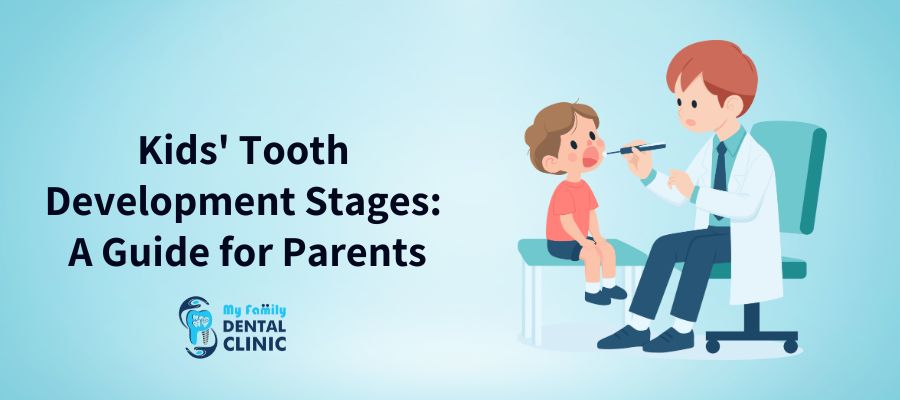At My Family Dental Clinic, we understand that your child’s smile is precious, and knowing how their teeth develop can help ensure a lifetime of healthy oral habits. In this blog, we’ll walk you through the different stages of tooth development in kids, providing insights and tips for parents to care for their little one’s teeth.
Stages of Tooth Development in Children
1. The Beginning: Tooth Development in the Womb
Tooth development begins before birth! By the time a baby is born, all 20 primary (baby) teeth are already formed beneath the gums. These teeth start developing around the sixth week of pregnancy, and by the third or fourth month, the hard tissues of the teeth begin to form.
2. The Eruption of Primary Teeth (6 Months – 3 Years)
The first visible sign of tooth development occurs when the baby’s teeth start erupting. This process usually follows a predictable timeline:
- 6-10 months: The lower central incisors (bottom front teeth) appear first.
- 8-12 months: The upper central incisors emerge.
- 9-16 months: The lateral incisors (next to the front teeth) come in.
- 13-19 months: The first molars (back teeth) erupt.
- 16-23 months: The canines (pointed teeth) appear.
- 23-33 months: The second molars (very back teeth) come in.
By age 3, most children have a full set of 20 primary teeth.
Related Read : When Should You Make Your Child’s First Dentist Appointment? A Complete Guide
3. Mixed Dentition Phase (6-12 Years)
This stage marks a transition from baby teeth to permanent teeth. It typically begins around age 6 when the first permanent molars and lower central incisors emerge. Over the next several years:
- The incisors and molars shed and are replaced by permanent teeth.
- Around age 10-12, the premolars replace the primary molars.
- By age 12-13, most children have nearly all of their adult teeth, except for wisdom teeth.
4. The Arrival of Permanent Teeth (12+ Years)
By the time your child reaches their teenage years, they will have 28 permanent teeth. Wisdom teeth, or third molars, may erupt between 17-25 years, but not everyone gets them.
Common Concerns About Tooth Development
1. Teething Discomfort
Teething can cause irritability, drooling, and mild discomfort. To ease this:
- Use a clean, chilled teething ring.
- Massage your baby’s gums with a clean finger.
- If necessary, consult your pediatric dentist for additional guidance.
2. Delayed Tooth Eruption
If a baby hasn’t developed their first tooth by 12-14 months, consult a pediatric dentist to check for underlying concerns.
3. Early Tooth Loss
Losing baby teeth too soon due to decay or injury can cause misalignment of permanent teeth. Regular dental check-ups can help prevent this.
4. Crooked or Crowded Teeth
Sometimes, permanent teeth may not have enough space, leading to crowding. Early orthodontic evaluation (around age 7) can help address alignment issues.
How to Care for Your Child’s Teeth at Each Stage
Infant Care (0-12 Months)
- Clean gums with a soft, damp cloth after feeding.
- Avoid putting your baby to sleep with a milk bottle to prevent tooth decay.
Toddler Care (1-3 Years)
- Start brushing with a soft-bristled toothbrush and a rice-sized amount of fluoride toothpaste.
- Schedule the first dental visit by age 1.
Preschool & School-Age Care (4-12 Years)
- Encourage proper brushing and flossing habits.
- Limit sugary snacks and drinks.
- Regular dental check-ups every 6 months.
Teen Dental Care (12+ Years)
- Monitor oral hygiene habits.
- Consider orthodontic evaluation if needed.
- Teach the importance of avoiding habits like nail-biting and chewing ice.
Why Choose My Family Dental Clinic?
At My Family Dental Clinic, we specialize in pediatric dentistry, ensuring your child’s oral health is in expert hands. Our experienced Dr. Shravani Deshpande-Sonar (MDS in Pediatric Dentistry) provides gentle, child-friendly care. Whether it’s teething concerns, cavities, or orthodontic needs, we are here to guide you every step of the way.


